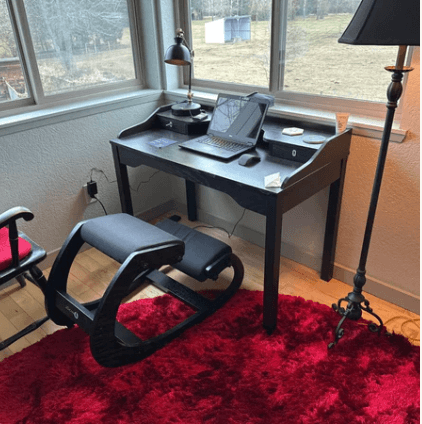Understanding the Foundation: What is a Kneeling Chair?
Are kneeling chairs good for hip pain in Australia? Yes, kneeling chairs can reduce hip pain by opening the hip angle and encouraging better posture. In Australia, many office workers benefit from these chairs as they relieve pressure on the hips and spine. For best results, pair ergonomic seating with regular movement and proper setup.
Are kneeling chairs good for hip pain in Australia? Yes, kneeling chairs can help relieve hip pain in Australia by promoting better posture and opening the hip angle. Their ergonomic design supports spinal alignment and core engagement, easing tension in the hips and lower back. For best results, use in combination with regular movement and proper chair adjustment.
A kneeling chair is a type of seat that positions its user in a way that the thighs are dropped to an angle of about 60 to 70 degrees from vertical, unlike a traditional chair where the angle is 90 degrees. This design encourages an active sitting posture by tilting the pelvis forward, aligning the spine, and engaging core muscles. They are often sought after in office spaces for their potential to reduce the discomfort associated with sitting for long periods.
The Ergonomic Design of Kneeling Chairs
Kneeling chairs boast an ergonomic design that aims to maintain the natural curve of the spine. By distributing the body's weight more evenly, these chairs reduce the reliance on the backrest and encourage the muscles engaged in maintaining posture to stay active. This minimizes the static posture typically associated with conventional seating, which can lead to discomfort over time.
Active Sitting and Its Impact on Your Body
Active sitting encourages continuous, minor adjustments of posture, which can help in strengthening core muscles and promoting better spinal health. Unlike static sitting, which can lead to muscle stiffness and decreased circulation, active sitting keeps muscles engaged. This dynamic approach to sitting may also encourage regular breaks to stand and stretch, further mitigating the risks of prolonged sitting.
By fostering movement, kneeling chairs can alleviate the pressure on hip joints and encourage a more open hip angle. This can be particularly beneficial for those wondering, "Are kneeling chairs good for hip flexors?" as the position can help in maintaining flexibility and reducing tightness in the hip area.
Moreover, the active engagement of the body can lead to improved concentration and productivity, as the slight movements keep the blood flowing and prevent the numbness or discomfort that often comes from sitting in one position for too long. Regular breaks to stand and move around are essential in complementing the benefits of active sitting, ensuring that the body remains agile and the mind focused.
A Brief History of the Kneeling Chair
The concept of the kneeling chair was introduced in the 1970s, aiming to offer a solution to the discomfort caused by prolonged sitting in traditional chairs. Its design encourages an active sitting posture by engaging core muscles and promoting spinal alignment, making it a popular choice for those seeking to improve their seating habits in the office space. Over the years, the kneeling chair has evolved but its primary goal remains the same: to support a healthier sitting posture.
Evolution from Traditional to Modern Office Furniture
The transition from traditional to modern office furniture reflects a growing awareness of the importance of ergonomics in the workspace. Terra Wellness kneeling chairs, with their unique design, have shifted from being a novelty to becoming a recognized solution for those suffering from back and hip pain. Their development over time highlights the ongoing search for seating options that not only provide comfort but also support overall health.
Today, kneeling chairs are available in various materials, adjustments, and styles, catering to a wide range of preferences and needs. They represent a significant shift towards acknowledging the role of furniture in ensuring a healthy work environment where employees can remain productive without compromising their physical well-being.
As more individuals and businesses recognize the potential long-term benefits of ergonomic seating, kneeling chairs continue to carve out a significant place in the modern office. Their evolution from traditional office chairs underscores a broader trend towards workplace wellness, emphasizing the value of investing in furniture that supports the body's natural posture.
The Core Benefits of Kneeling Chairs for Hip and Back Health
Kneeling chairs offer several advantages for individuals experiencing hip and back pain. By sitting in a kneeling chair, one can promote muscle development in the core and back, potentially alleviating discomfort in these areas. The design of the chair ensures that sitting pressure is more evenly distributed, reducing the strain on any one part of the body.
Promoting a Better Posture
One of the significant benefits of kneeling chairs is their ability to promote better posture. Unlike traditional office chairs that often encourage slouching and can lead to a loss of lumbar curvature, kneeling chairs support an active sitting posture. This not only helps in maintaining the lumbar curvature but also encourages an improvement in your core strength. The potential benefits of sitting in a kneeling chair over a standard computer chair include reduced back pain and a more naturally aligned spine.
Pros: How Kneeling Chairs Encourage Spinal Alignment
Kneeling chairs support spinal alignment by promoting an active sitting posture that naturally aligns the spine. This reduces the tendency to slump or adopt a static posture, which is common with traditional seating. By encouraging the spine's natural curvature, kneeling chairs can help in preventing the discomfort associated with long periods of sitting.
The design of these chairs ensures that the body's weight is distributed more evenly, which can reduce the pressure on the spinal discs. This aspect is crucial for those who spend long hours seated, as it can help in mitigating the risks of developing chronic back issues.
Additionally, the active engagement of core muscles required to maintain balance on a kneeling chair further assists in strengthening the back and abdominal muscles. This muscle engagement is essential for supporting the spine and can lead to significant improvements in overall posture and spinal health.
Alleviating Pressure on Hips and Lower Back
The ergonomic design of kneeling chairs can help in alleviating pressure on the hips and lower back. By positioning the user with an open hip angle, these chairs ensure that the hips and thighs are supported, reducing the strain often experienced in conventional seating arrangements. This can be particularly beneficial for individuals suffering from hip pain or those seeking to maintain healthy hip flexors.
Cons: Potential Challenges in Adjusting to Kneeling Chairs
Despite the benefits, transitioning to a kneeling chair can present challenges. Initially, users may experience discomfort as their body adjusts to a new way of sitting. This adjustment period is necessary as the body acclimatizes to engaging different muscles for support and maintaining balance.
Furthermore, kneeling chairs may not be suitable for everyone, especially individuals with knee or shin issues, as the design places more pressure on these areas than traditional chairs. It's essential for potential users to consider their personal health conditions when deciding to switch.
Lastly, while kneeling chairs can significantly benefit spinal alignment and reduce back pain, they should be used in moderation. Like any seating arrangement, taking regular breaks to stand and move around is crucial for preventing stiffness and encouraging circulation. This holistic approach to office ergonomics ensures that the benefits of kneeling chairs are fully realized without introducing new issues.
Real-Life Experience: Transitioning to a Kneeling Chair
Adopting a kneeling chair from traditional office chairs marks a considerable shift in how one interacts with their workspace. Initially, the transition may seem daunting, given the distinct design and posture the kneeling chair promotes. However, the journey from skepticism to adaptation reveals much about the chair's potential benefits for those experiencing hip pain and seeking improved posture.
My Initial Week with a Kneeling Chair
The first week of using a kneeling chair introduced a novel sitting experience, contrasting significantly with the slouched posture often fostered by traditional office chairs. This period required an adjustment, as the body acclimatized to the new posture, promoting core muscle engagement and a more upright spine.
Personal Observations on Comfort and Adaptability
Upon beginning the kneeling chair journey, the initial feeling was one of unfamiliarity, especially concerning the engagement of core muscles that are typically less active while sitting in traditional chairs. The chair's design, which encourages a forward tilt, necessitates an active sitting posture, fostering muscle engagement and potentially reducing the strain on the hips and lower back.
Comfort levels varied during the first few days, with moments of adjustment and discovery. Learning to distribute weight between the seat and the shin pads, instead of relying solely on the buttocks for support, marked a significant adaptation phase. This distribution is crucial for reducing pressure points and enhancing comfort during prolonged periods of sitting.
Adaptability to the kneeling chair was a gradual process, influenced by personal willingness to embrace change and the body's ability to adjust to new postures. By the end of the first week, noticeable improvements in posture were evident, laying the groundwork for assessing long-term benefits.
Long-Term Use: Assessing Changes in Hip Pain and Posture
Extended use of the kneeling chair brought to light its potential to alleviate hip pain and contribute to a healthier posture. Continuous engagement of the core muscles and the promotion of spinal alignment played pivotal roles in these improvements, underscoring the chair's design philosophy.
Insights from Extended Use Beyond the First Week
Over time, the kneeling chair not only facilitated a more natural spinal curve but also encouraged movement and adjustments in seating position, which can be beneficial for those with hip pain. The dynamic nature of sitting in a kneeling chair means less static pressure on the hips and lower back, potentially reducing discomfort and stiffness.
The extended use highlighted the chair's capacity to influence posture positively. Users often report a natural tendency towards an upright position, even when not sitting in the chair, indicating a lasting impact on their awareness and posture habits. This shift could prove invaluable for individuals experiencing chronic hip pain or who wish to prevent such issues.
However, it's crucial to note that the benefits of a kneeling chair, including its impact on hip pain and posture, may vary between individuals. Factors such as the duration of sitting, existing musculoskeletal conditions, and the specific design of the kneeling chair itself play significant roles in determining the chair's effectiveness for each user.
Detailed Analysis: Kneeling Chairs Versus Traditional Chairs
When analyzing kneeling chairs in contrast to traditional chairs, several aspects come to the forefront, including the ergonomic design, the impact on spinal alignment, and the ability to alleviate aches and pains. These chairs offer a unique sitting experience that may significantly influence one's comfort and health in an office environment.
Side-by-Side Comparison for Hip Pain Relief
For individuals spending extensive periods sitting at a desk, the comparison between kneeling chairs and traditional desk chairs is particularly relevant. Kneeling chairs promote an open hip angle, which can reduce pressure on the hips and encourage a more dynamic form of sitting, potentially offering relief from hip pain.
Ergonomic Benefits Unique to Kneeling Chairs
Kneeling chairs stand out for their emphasis on promoting an active sitting posture, which engages the core muscles and supports spinal alignment. This ergonomic design contrasts with the static nature of traditional chairs, where the tilt of the seat and the inability to adjust the seat height can lead to slouching and subsequent discomfort.
The inclusion of shin pads in kneeling chairs redistributes weight away from the lower back and hips, offering an alternative sitting position that may benefit individuals with hip flexors or back pain. This redistribution can mitigate the common aches and pains associated with prolonged sitting in a conventional desk chair.
Moreover, the kneeling chair's design encourages periodic movement, allowing users to adjust their position and engage different muscle groups throughout the day. This dynamic approach to sitting contrasts with the sedentary nature of traditional office environments, potentially offering a healthier alternative for long-term desk work.
Considerations Before Making the Switch
Transitioning to a kneeling chair requires careful consideration, especially for individuals with existing back pain or those accustomed to standing desks. The chair's design, while beneficial for many, may not suit everyone's needs or preferences.
Suitability for Back Pain Sufferers and Ergonomic Safety
Kneeling chairs can offer substantial benefits for core muscle engagement and posture correction, potentially aiding those with back pain. However, the suitability of such chairs varies, with some individuals finding greater relief through alternatives like standing desks or ergonomic office chairs designed specifically for back support.
Ergonomic safety remains paramount when considering a kneeling chair. Users should ensure the chair is correctly adjusted to their body size and desk height, promoting optimal spinal alignment and reducing the risk of strain. Regular breaks and stretching exercises are also recommended to complement the benefits of the kneeling chair.
Ultimately, the decision to switch to a kneeling chair should be informed by an understanding of one's personal health needs, work habits, and the specific ergonomic benefits the chair offers. Consulting with a healthcare professional can provide valuable insights into whether a kneeling chair could be a beneficial addition to one's work environment.
Making an Informed Decision: Is a Kneeling Chair Right for You?
Choosing a kneeling chair involves evaluating various factors, including the potential benefits for hip pain relief, the need for improved posture, and the suitability of the chair for one's office environment. The decision should be based on a comprehensive understanding of how the chair's design impacts hip angle and overall comfort.
Evaluating Your Personal Needs and Office Environment
When considering a kneeling chair, it's essential to assess both personal health needs and the specifics of the office environment. Factors such as the amount of time spent sitting, existing issues with hip pain or posture, and the physical layout of the workspace all play critical roles in this decision-making process.
Adjusting the Chair for Optimal Comfort and Efficacy
For those who decide to proceed with a kneeling chair, finding the right adjustments is key to maximizing its benefits. This includes setting the correct tilt of the seat to ensure an open hip angle, which can alleviate pressure on the hips and encourage a more active sitting posture.
Additionally, the ability to adjust the seat height and position relative to the desk is crucial for maintaining proper spinal alignment and avoiding unnecessary strain. Users should take the time to experiment with different settings to find the most comfortable and supportive configuration for their body type and work activities.
Regular evaluation and adjustment of the chair's settings may be necessary as one becomes more accustomed to the kneeling posture. Paying attention to the body's signals and making changes as needed can help ensure the chair continues to offer the desired benefits for hip pain relief and posture improvement over time.
Final Thoughts: Embracing Change for a Healthier Posture
Embracing the shift to a kneeling chair represents more than just a change in seating; it's a step towards prioritizing and maintaining good posture. This transition, while it may require some adjustment, underscores the importance of being proactive about spinal health. It's about making an informed choice to support the body's natural alignment and promote overall well-being.
The Verdict on Kneeling Chairs and Hip Pain Relief
The question of whether kneeling chairs are good for hip pain is met with a positive outlook. These chairs are designed to distribute the body's weight more evenly, reducing the pressure on the hips and encouraging a posture that aligns the spine. Consequently, for individuals experiencing discomfort in their hips or lower back, kneeling chairs offer a promising solution. The unique design supports the body in a way that traditional chairs cannot, directly addressing the concerns related to hip pain and discomfort.
Moreover, kneeling chairs are beneficial for the hip flexors, a group of muscles that are often neglected in typical seating arrangements. By promoting an open hip angle, these chairs encourage a more dynamic sitting posture. This not only alleviates existing hip pain but also contributes to the prevention of future discomfort. The active sitting position fostered by kneeling chairs helps to strengthen the core muscles, further supporting the body's posture and reducing strain on the hips and back.
However, it is crucial to recognize that kneeling chairs may not be the perfect solution for everyone. The adjustment period can be challenging for some, and individuals with specific health conditions should consult a healthcare professional before making the switch. The key is to evaluate personal needs and consider how a kneeling chair can fit into one's daily life. For those wondering, "Are kneeling chairs good for back pain?" the evidence suggests a positive impact, provided the user takes the time to adjust to the new seating style. Ultimately, kneeling chairs represent a viable option for those seeking relief from hip and back pain, offering a fresh perspective on how we sit and how it affects our health.
Use code BLOG20 at checkout for 20% OFF your Terra Wellness kneeling chair today.
👉 (Shop Now ➜)
FAQs About Kneeling Chairs and Hip Pain
Q1: Are kneeling chairs good for hip pain in Australia?
A: Yes. Kneeling chairs promote a more open hip angle and reduce compression in the lower back and hips. Many Australians find relief using them in home and office settings.
Q2: How do kneeling chairs help hip flexors?
A: They keep the hip flexors elongated and active rather than compressed, reducing stiffness and aiding flexibility over time.
Q3: Can kneeling chairs be used at a standard office desk?
A: Yes. Most kneeling chairs suit standard Australian desk heights, but pairing them with an adjustable desk can further improve posture.
Q4: Are kneeling chairs suitable for long hours of work?
A: They're ideal for shorter sitting sessions (30–60 minutes at a time). Alternate with standing or standard ergonomic chairs to avoid pressure on the knees and shins.
Q5: Who should avoid kneeling chairs?
A: People with pre-existing knee issues, poor circulation, or recovering from lower limb injuries should consult a health professional before use.






